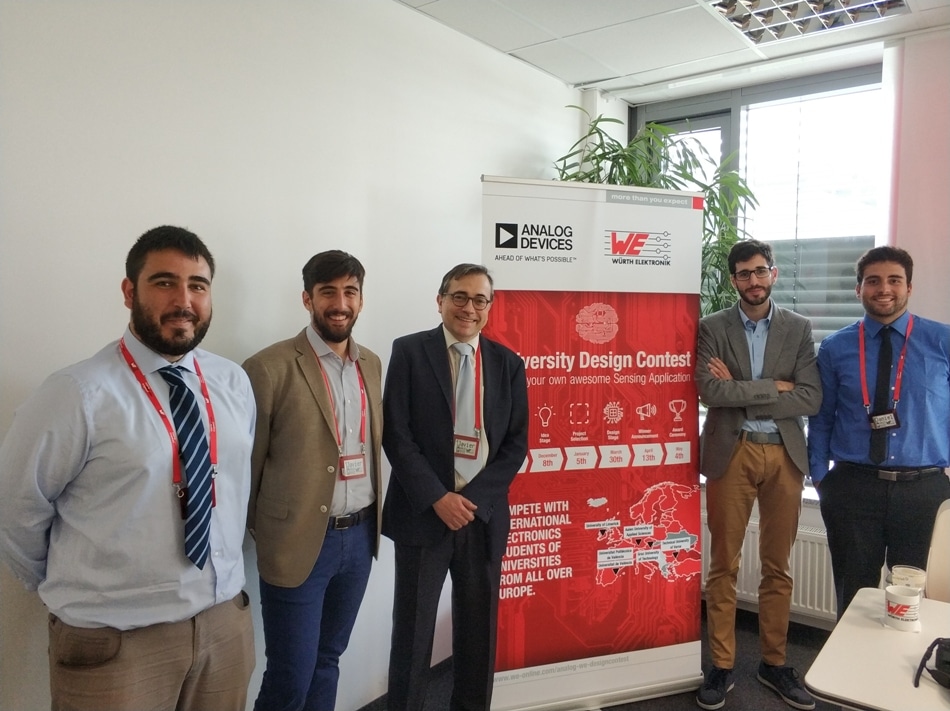Jun 1 2018
The team comprised of Daniel Iordanov, Andima Beitia, Javier Silva and Roque Belda, students of the Biomedical Engineering Master’s Degree of the Unviersitat Politècnica de València (UPV), has been one of the winners of the First European University Design Contest, a competition promoted by companies Analog Devices (ADI) and Würth Elektronik (WE).
 Credit: RUVID
Credit: RUVID
The UPV students have been rewarded for their Health Ear project, where they developed an intelligent headphone prototype which was able to measure the user’s hearing ability performing regular hearing tests similar to a tympanometry. This idea is specially useful for people who use headphones on a daily basis as well as for those who are susceptible to developing hearing deficiencies, as the device can detect the appearance of pathologies such as the initial stages of otitis and advise the user to get a medical check-up.
“The device is placed over the ear and dynamically minimises noise. Even so, the most relevant fact is that this reduction is performed taking into account the characteristics of the external noise and adapts it to the sensibility of each person specifically,” highlights Roque Belda.
The equipment includes a sensor comprised of a microphone and a small speaker which make it possible to emit the pulse and receive the eco signal, as well as an external microphone that registers ambient noise. All these elements are included in the headphone’s casing.
As Javier Silva explains, the microphone that picks up external noise makes it possible to automatically adjust the volume. This way, in surroundings with louder external noise, the volume will progressively increase until it reaches a non-harmful level for the user’s hearing. “When ambient noise decreases, the volume drops as a result so the user doesn’t have to be concerned with adjusting the volume, which can lead to them causing themselves damage involuntarily by using high volumes for too long,” adds Silva.
Early detection
In this sense, Daniel Iordanov adds that after acquiring the three signals (the one without an eco and the ones from both ears) you can see the pulse signal, the eco and the dimmed signal. “With that, we can extract parameters that help quantify the response of each ear and lower the noise depending on the characteristics of each user.”
With this information and by way of a method developed by Health Ear, a figure is obtained which quantifies hearing health, a figure which is regularly checked to identify the appearance of possible issues.
“This step allows people to detect a problem early on, visiting the doctor on time to be able to perform an intervention which minimises the harmful effects of potential hearing pathologies,” says Jaime Marco Algarra, chief of the otolaryngology department of the Hospital Clínico de Valencia, president of the CODEPEH and medical advisor of the team.
Another main feature of the Health Ear prototype is its innovative design, in the shape of a tear. “We did market research and decided to give it this shape. This design allows us to place both the speaker and microphone directly pointing to the ear canal, which makes it possible to obtain a better signal with less noise,” adds Andima Beitia.
Other fields
Aside from the world of consumer electronics, where headphones are commonplace all over the world, this technique could be used for the development of hearing protectors which make it possible to monitor the hearing of workers (construction workers, people in the military, factory workers…) which are typically surrounded by large quantities of ambient noise, so they have better control over their hearing health.
The Health Ear team was invited to Munich along with the winning teams of other categories of the competition back on May 4, where the award ceremony was held, and they were able to visit the headquarters of both organising companies. During the ceremony, their entrepreneurial spirit was praised, as well as the multidisciplinary and heterogeneous nature of the team.
The development of Health Ear was aided by Higher Technical School of Telecommunication Engineers of the Universitat Politècnica de València professor Germán Ramos, and by the designer and European project coordinator Miguel Pizá (UPV-CPI2020).
As well as currently studying the Master’s degree in Biomedical Engineering of the UPV, Daniel Iordanov, Andima Beitia, Javier Silva and Roque Belda are graduates from Madrid’s Universidad Politécnica, the Universidad de Mondragón, Universidad de Extremadura and Universidad Politécnica de Cartagena, respectively.